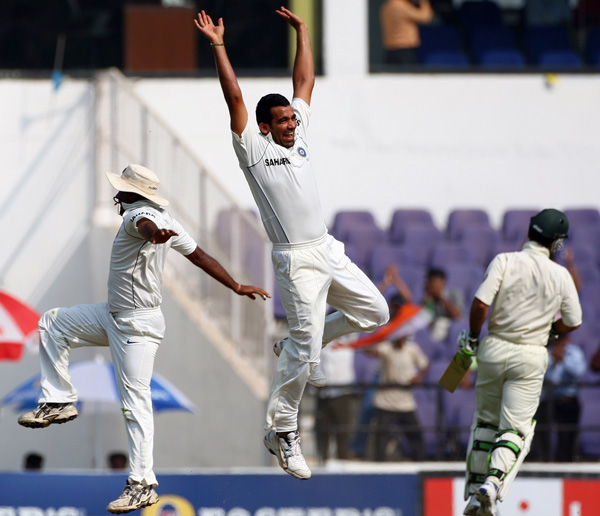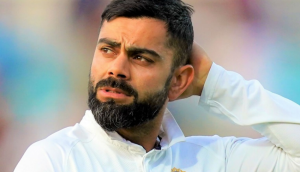Adieu Zaheer Khan: the man who gave India its bowling mojo

The farewell
- Fast bowler Zaheer Khan has announced his retirement from international cricket
- Zaheer was one of the pillars of the Indian team throghout the 2000s
- He revived the art of fast bowling in India
The figures
- The 37-year-old fast bowler made his debut in 2000
- He took 311 wickets in 92 Tests at an average of 32.94 runs per wicket
- In ODIs, he took 282 wickets in 200 matches at an average of 29.43
More in the story
- Is Zaheer the greatest Indian fast bowler ever?
- From injuries to form, what were the ups and downs in his career?
- How India\'s owes its rediscovery of fast-bowling to Zaheer?
To Indian cricket fans, the Y2K disaster was real. It manifested itself in the form of the match-fixing scandal of 2000. No one knew what to trust anymore - whether all the emotions one was investing in the ups and downs of the national team were even worth it.
It was at this time that the legend of Sourav Ganguly and his merry men was born. He was the hero Indian cricket needed; a daring captain who backed his young troops in success and failure, and reshaped the modern Indian cricket team. They responded to his style, and channeled their positive attitude and edginess into their on-field demeanour and performances.
India has always been blessed with batsmen and spinners galore, but the one thing needed to succeed around the world that the team lacked for a long, long time was a genuine fast bowler.
Javagal Srinath had given yeoman service to the country but had had to slow down to nurse his shoulder. The situation was so dire that sometimes, the second-fastest bowler in the team was the military-medium Ganguly himself.
Enter Zaheer Khan. Indian cricket would never be the same again.
The yorker that opened India's eyes
It was in 1932 that India first took to the field in a Test match, armed with 'real' pace bowlers Mohammad Nissar and Amar Singh. Over the next 65-plus years, the country seemed to forget what an asset a fast bowler could be.
Kapil Dev, for all his greatness, relied on swing - he just wasn't an express pace bowler.
Srinath started out as a quick bowler, but sacrificed it for accuracy and longevity. As for the rest, including Manoj Prabhakar and Venkatesh Prasad, the old joke stood - sometimes leg-spinner Anil Kumble was quicker than them.
It's one of (Test) cricket's truisms that the batsmen can set up or save a game
Then, at the ICC KnockOut tournament in Nairobi, almost exactly 15 years ago, a full toss/yorker broke through the citadel that was Steve Waugh's technique.
India watched with its eyes wide open. It had found its answer to Wasim Akram. There had been glimpses of the talent when Zaheer led Baroda to the Ranji Trophy title in 2000. But he had already left his mark on the international stage.
The horror
Ganguly's men recovered from a horror start to the 2003 World Cup (which led to some violent protests back home) to reach the final. They faced the all-conquering Aussies in the final in Johannesburg.
The India captain won the toss and chose to field. He handed the new ball to his trusted lieutenant. The lieutenant was obviously nervous, and gave away 15 runs off the opening over, including a bevy of extras.
Australia ended up posting 359/2, and India never recovered.
The young fast bowler was shattered. But at least his house in the small town of Shrirampur, Maharashtra, wasn't vandalised like Mohammad Kaif's in Allahabad earlier in the tournament.
Discovering oneself on greener pastures

Amit Mishra and Zaheer Khan of India celebrate the run out of Ricky Ponting during a test match in 2008. Photo: Michael Steele/Getty Images
After three years of up-and-down form, he was dropped from the national side, but got a call from the English county Worcestershire. He went to England, and over the course of the summer, seemed to discover himself.
Back in the team at peak fitness and with a more developed skill-set, he blew away South Africa in the Johannesburg Test of 2006, in the process starting his long feud with South Africa captain Graeme Smith. Zaheer won that battle more often than not, and made Smith his bunny.
Zaheer Khan announced his retirement from international cricket after 15 years at the top level
Some months later, he set up one of India's greatest Test wins against England in Nottingham. This one would have felt even sweeter - when he walked out to bat, he was greeted by the pranksters in the England team with jellybeans on the pitch.
There was all sorts of bat-waving and threats from Zaheer in the general direction of Kevin Pietersen, but he followed up his four-wicket haul in the first essay with a five-wicket burst in the second to win India the Test and, eventually, the series.
Master of his craft
When MS Dhoni took over the leadership of the team in 2008, he made Zaheer the de-facto bowling captain. Standing at mid-off or mid-on, it was a common sight to see Zaheer talk to youngsters like Ishant Sharma after every delivery, discussing strategy and field placings. And the results started going India's way.
The likes of Tendulkar, Dravid, Kumble and Laxman had established themselves in the team before the match-fixing scandal broke out. But the ones who came after, viz. Sehwag, Yuvraj, Harbhajan and Zaheer, were the pillars of the Indian team of the 2000s.
They propped up Indian cricket for nearly a decade-and-a-half. No, scratch that. They elevated Indian cricket to new heights.
It's one of (Test) cricket's truisms that the batsmen can set up or save a game; it's the bowlers who win it. Zaheer, a master of pace, variations, and swing - both conventional and reverse - proved it.
If only injuries hadn't taken their toll on his body, Zaheer could have probably ended the debate over India's greatest fast bowler. But despite them, the 37-year-old fast bowler finished with 311 wickets in 92 Tests at an average of 32.94 runs per wicket, and 282 wickets in 200 ODIs at 29.43.
Still need more proof of Zaheer's greatness? Here's what Sri Lankan legend Kumar Sangakkara said about his long-time adversary: "Zaheer was a nightmare to face because he was so skillful. He had the ability to seam the ball as well as swing it both ways. He was absolutely sure of himself. He knew exactly what he was doing. Reverse, he was just the master. I have a lot of respect for Zaheer, the way he bowled not just to me but around the world in all conditions."
As Zaheer bids adieu to international cricket, with just the ninth season of the Indian Premier League standing between him and the walk into the sunset, it's time to offer our thanks to a great servant of Indian cricket.
From raw talent to a master of his craft, Zaheer epitomised Indian cricket of the 2000s. And if India has some noteworthy pace bowlers today, it's partly thanks to the example set by Zaheer.
First published: 15 October 2015, 9:04 IST






![BJP's Kapil Mishra recreates Shankar Mahadevan’s ‘Breathless’ song to highlight Delhi pollution [WATCH] BJP's Kapil Mishra recreates Shankar Mahadevan’s ‘Breathless’ song to highlight Delhi pollution [WATCH]](https://images.catchnews.com/upload/2022/11/03/kapil-mishra_240884_300x172.png)

![Anupam Kher shares pictures of his toned body on 67th birthday [MUST SEE] Anupam Kher shares pictures of his toned body on 67th birthday [MUST SEE]](https://images.catchnews.com/upload/2022/03/07/Anupam_kher_231145_300x172.jpg)






